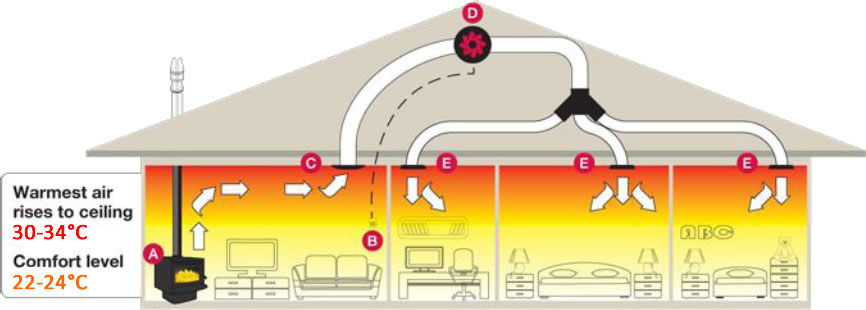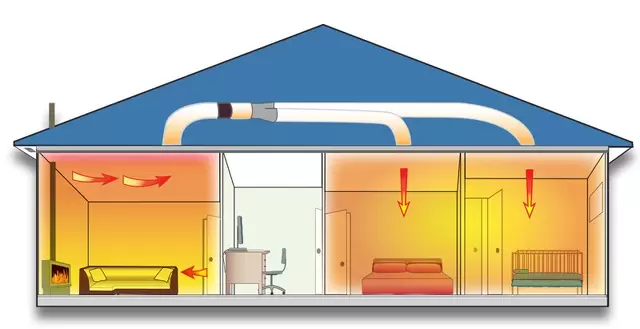DVS Heat Transfer Systems: The Future of Energy-Efficient Industrial Heating Solutions
Wiki Article
A Comprehensive Overview to Picking the Right Heat Transfer Systems for Your Requirements
Choosing the proper Heat transfer system is vital for functional efficiency. Various systems deal with various requirements, influenced by factors such as temperature array and fluid kind. Comprehending the concepts behind Heat transfer, such as transmission, radiation, and convection, is essential. Additionally, evaluating power resources and upkeep practices can affect long-lasting performance. A closer evaluation of these considerations reveals how to customize a system to certain requirements. What should one prioritize in this facility decision-making procedure?Recognizing Heat Transfer: Secret Ideas and Principles
Although Heat transfer might feel like an uncomplicated principle, it encompasses a series of concepts that are basic for effective system style. Understanding these concepts is vital for designers and designers who intend to maximize thermal efficiency in numerous applications. Conduction, as an example, entails the transfer of Heat with strong materials, while convection describes the movement of Heat within liquids. Radiation, one more key concept, describes how Heat can be moved through electro-magnetic waves. Each of these devices plays an important duty in figuring out how energy moves within a system. By extensively comprehending these ideas, professionals can make enlightened decisions, making certain that Heat transfer systems run successfully and satisfy the certain demands of their applications
Kinds Of Heat Transfer Equipments: A Review
Comprehending the principles of Heat transfer prepares for exploring the numerous kinds of Heat transfer systems available. Heat transfer systems can be categorized largely into 3 types: conduction, radiation, and convection. Transmission involves Heat transfer via solid products, relying on direct call between particles. Convection, on the other hand, takes place in fluids (fluids and gases) where the activity of the fluid itself facilitates Heat transfer. Radiation entails the transfer of Heat through electromagnetic waves and does not need a medium, enabling it to take place in a vacuum. Each type of system has unique attributes and applications, making it essential for individuals and organizations to thoroughly examine their certain requirements when picking the most appropriate Heat transfer solution.Applications of Heat Transfer Solutions in Different Industries
Heat transfer systems play a vital duty throughout various sectors, impacting efficiency and item top quality. In industrial manufacturing procedures, they help with accurate temperature level control, while in food and beverage handling, they guarantee safety and security and conservation. Furthermore, HVAC and environment control systems rely heavily on effective Heat transfer to maintain comfy settings.Industrial Production Processes

Various industrial manufacturing processes depend heavily on reliable Heat transfer systems to make best use of productivity and improve product quality. In fields such as metalworking, Heat exchangers play an essential function in preserving suitable temperature levels during welding, spreading, and building. These systems ensure consistent Heat distribution, which is crucial for attaining wanted product residential or commercial properties. In a similar way, in the chemical production sector, Heat transfer systems assist in exact temperature control during reactions, affecting return and security. Additionally, in fabric production, efficient Heat monitoring is necessary for coloring and completing processes, affecting color consistency and textile high quality. By choosing proper Heat transfer modern technologies, producers can improve energy performance and reduce operational costs, ultimately causing a more competitive and sustainable manufacturing setting.
Food and Beverage Processing
Effective Heat transfer systems are equally vital in the food and drink processing industry, where keeping optimal temperatures is essential for food security and quality. These systems play a vital function in processes such as pasteurization, cooking, and sanitation, making certain that products are safe for consumption and preserve their nutritional worth. Heat exchangers, for circumstances, efficiently transfer Heat in between fluids, optimizing power usage while minimizing temperature changes. In addition, refrigeration systems are essential for protecting subject to spoiling items and expanding life span. The selection of Heat transfer innovation straight influences operational efficiency and product honesty, making it vital for food and beverage suppliers to pick the suitable systems tailored to their certain processing requirements. This cautious selection eventually contributes to customer contentment and food safety.
Heating And Cooling and Environment Control
While numerous industries depend on Heat transfer systems for performance, HVAC (Heating, Air Flow, and A/c) plays a necessary role in preserving interior climate control across different setups. These systems make use of Heat transfer concepts to control air, humidity, and temperature quality, making sure comfort and safety and security in domestic, business, and industrial atmospheres. Properly designed heating and cooling systems improve power efficiency, decrease operational costs, and minimize ecological effect. In business buildings, as an example, reliable climate control adds to employee productivity and consumer satisfaction. In industrial applications, heating and cooling systems aid keep perfect conditions for tools operation and item preservation. Picking the appropriate Heat transfer system is vital for conference particular environment control needs and accomplishing general system performance.Reviewing Energy Resources for Heat Transfer Solutions
In reviewing energy resources for Heat transfer systems, a comparison of renewable resource alternatives and nonrenewable fuel source considerations is necessary. Eco-friendly resources, such as solar and wind, offer sustainable options that can minimize ecological impact. Conversely, fossil gas stay prevalent as a result of their well-known infrastructure and energy density, prompting a careful evaluation of both choices.Renewable Energy Options

Nonrenewable Fuel Source Factors To Consider
Reviewing nonrenewable fuel source considerations is necessary for the performance and sustainability of Heat transfer systems. Nonrenewable fuel sources, such as gas, oil, and coal, are conventional energy resources that supply substantial Heat outcome, making them popular selections for domestic and industrial applications. Their environmental impact, including greenhouse gas emissions and resource exhaustion, raises problems. When selecting a heat transfer system, it is important to analyze the schedule, price, and regulatory aspects related to these fuels. In addition, the effectiveness of nonrenewable fuel source systems must be taken into consideration, as greater performance can reduce some environmental drawbacks. Inevitably, a balanced technique considering efficiency and sustainability can guide decision-makers towards one of the most appropriate Heat transfer service for their certain demands.Variables to Think About When Choosing a Warm Transfer System
Choosing an ideal Heat transfer system needs cautious factor to consider of numerous factors that can considerably impact efficiency and performance. One important factor is the operating temperature variety, which determines the products and style ideal for the application. In addition, the kind of fluid used in the system-- whether gas or fluid-- influences Heat transfer effectiveness and compatibility. The system's size and capability must line up with the certain requirements of the operation to stay clear of ineffectiveness. Energy resource accessibility is also crucial, affecting operating expense and sustainability. In addition, the setup environment, including room restraints and access for upkeep, plays a substantial role in system selection. Ultimately, regulative conformity and security criteria have to be considered to ensure the system satisfies all legal requirements.Maintenance and Performance Optimization for Heat Transfer Equipments
Maintaining Heat transfer systems is crucial for making sure maximum efficiency and long life. Routine upkeep activities, such as cleansing Heat exchangers and evaluating insulation, help avoid effectiveness losses due to fouling and thermal linking. In addition, monitoring system criteria, consisting of stress and temperature, permits very early discovery of abnormalities, lessening downtime and expensive repairs. Applying a preventative upkeep schedule can enhance performance and extend the lifespan of parts. Updating to advanced control systems can boost functional performance by adjusting to varying conditions and loads. By prioritizing maintenance and performance optimization, operators can accomplish minimized energy usage, lower operational costs, and boosted general system dependability, eventually resulting in better source use and a much more lasting operation.Future Trends in Heat Transfer Technologies
As sectors progressively focus on sustainability and power performance, future fads in Heat transfer technologies are established to undergo substantial makeovers. Advancements such as advanced materials, consisting of carbon nanotubes and nanofluids, promise boosted thermal conductivity and performance. In addition, the assimilation of eco-friendly power sources right into Heat transfer systems is getting momentum, promoting green options. Smart innovations, including IoT sensing units, are anticipated to reinvent monitoring and control, allowing real-time data analysis for optimized performance. Additionally, the advancement of small and modular systems will facilitate less complicated setup and maintenance, catering to diverse applications. These improvements indicate a shift towards even more sustainable, efficient, and versatile Heat transfer remedies, straightening with international power objectives and ecological requirements.
Frequently Asked Inquiries
What Are the Environmental Influences of Heat Transfer Equipments?
The environmental influences of Heat transfer systems can include greenhouse gas discharges, power usage, and prospective thermal pollution. In addition, improper disposal of materials and inefficiencies can contribute to source exhaustion and ecological community DVS Heat Transfer Systems disturbance.Exactly how Do I Compute the Cost-Effectiveness of a Warm Transfer System?
To compute the cost-effectiveness of a warmth transfer system, one should assess first costs, functional expenditures, upkeep requirements, and energy efficiency, comparing these elements against the expected lifespan and performance of the system.Can Heat Transfer Systems Be Used in Residential Setups?
Heat transfer systems can certainly be made use of in domestic setups. They give efficient home heating and cooling down options, making homes extra comfortable while possibly lowering energy expenses. Their adaptability permits different applications in domestic atmospheres.What Safety And Security Laws Apply to Heat Transfer Solutions?
Safety regulations for Heat transfer systems usually include guidelines on maintenance, operation, and setup. Compliance with regional building regulations, maker specs, and sector requirements is necessary to ensure efficient and safe system performance in numerous applications.Just How Do Different Materials Affect Heat Transfer Efficiency?

Transmission, for circumstances, involves the transfer of Heat with solid products, while convection refers to the motion of Heat within fluids. Understanding the concepts of Heat transfer lays the groundwork for discovering the different types of Heat transfer systems offered. Heat exchangers, for circumstances, effectively move Heat between liquids, maximizing energy usage while lessening temperature variations. In evaluating energy sources for Heat transfer systems, a contrast of eco-friendly energy options and fossil fuel factors to consider is crucial. Metals, such as copper and aluminum, conduct Heat successfully, whereas insulators like rubber and glass slow down Heat flow.
Report this wiki page